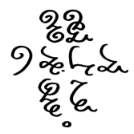All Activity
- Past hour
-
Hello again @Krisp! I love the delicate piano dissonance accompanying your voice in this song. You usually include English subtitles in your compositions but I was disappointed to see that you didn't in this performance. It would be great to know what the words mean when you're singing! But I do like that you show the notes of your composition much more clearly than before in this video. Thanks for sharing!
-
Hey @Henry Ng Tsz Kiu! I don't know how I haven't yet mentioned this but I like how the main Arjuna theme is a clever set of enclosures around a single tone. By approaching a tone by both overshooting and undershooting it with a leading tone from below you create a nice sense of approaching the tone from all directions. I love the romanticism of Variation III with its minor subdominant. Variation V takes up your now characteristic play with pentatonic scales. The fugato variation is brisk and full of vitality and life which brings the movement to an exciting and energetic conclusion! Thanks for sharing!
- Today
-
Hi @ferrum.wav! I listened to the original track and your first variation immediately afterward. They do transition into each other very smoothly! I think making small changes to each successive variation is going to be the best way to eventually make the piece sound more and more different from the original (but still audibly related) as possible. That's what I always find most exciting about variation form is that it successively sounds more and more different and further removed from the original and brings a surprising sense of variety despite still being audibly connected to the original theme. Thanks for sharing and good luck on your successive variations! P.S.: I've also recently finished a movement of a giant variations piece. Check it out if you have a chance!
-
Hi @Some Guy That writes Music! I think writing music that modulates from the get-go without first establishing a tonic key in the main theme is difficult. But you do somehow manage to achieve this with the help of sometimes repeating a musical gesture again to solidify the feeling that, yes, you did mean to do that. Wagner was the composer in music history that was known for the "art of transition" right? I like how the piece builds tension, momentum and dissonance towards the end. But I do feel like the piece just stops and could easily be continued. Cool piece! Thanks for sharing. P.S.: Don't forget to acknowledge the people who have taken the time to review your music by giving them (myself included LoL) a ❤️ or a 🏆!
-
PeterthePapercomPoser started following Litanie
-
Henry Ng Tsz Kiu started following Shinobi III '80s Action Movie Arrangement and Practice on Scriabin style
-
PeterthePapercomPoser started following Otherworldly euphoria and Shinobi III '80s Action Movie Arrangement
-
Hi @Samuel_vangogh! Is this a recording of you playing your own music? Very good job on that front! Now if only you finished the piece and performed and recorded it yourself, I'd give you the "Star Performer" badge! LoL But very cool idea so far. Is this a study on 4ths? What are the light purple highlighted sections? Thanks for sharing!
-
.thumb.png.8b5b433a341551e913a34392660bc95b.png)
Short Lutheran chorale I made yesterday
PeterthePapercomPoser replied to mossy84's topic in Choral, Vocal
Hi @mossy84! What an amazingly realistic sound rendition! It's too bad you're only using it to write traditional chorales. Imagine what kind of amazing choral pieces you could make if you weren't limited by common practice harmony! Thanks for sharing. -
.thumb.png.8b5b433a341551e913a34392660bc95b.png)
Toccata-Scherzo (2025) for piano
PeterthePapercomPoser replied to 林家興's topic in Piano Music, Solo Keyboard
Hi @林家興! What a surprising and accessible sound you create with the slightly swung 16th notes! This soon gives way to a B section that's very jazzy. I really like the slow retransition back to the main material with an accelerando at the end. It's very easy to listen to and understand and you capture this listener's heart with the sparkling and twinkling high piano notes that are like glistening icicles. You display quite a lot of craft in this short and (somewhat) simple little piece. I can't keep myself from listening to this over and over. Thanks for sharing! -
I don't have much to do with cover tunes or video game music these days, but with new Ninja Gaidens and Shinobi games coming out, it appears 2025 is indeed the year the ninja master returned. I have better gear than they did back in '93, so I arranged the theme from Shinobi 3 in the '80s martial arts film score style I believe they were going for on that old Sega soundchip!
- 1 reply
-
- 1
-

-
Hi @Fugax Contrapunctus! Very cool idea! I actually do something like this harmonically speaking in my Variations on "Deck the Halls" for Piano and Orchestra. I cycle through the whole circle of 5ths twice over before returning back to the home key, although it's not a canon. Very effective orchestration here, starting with just strings, adding woodwinds and then introducing the choir - very multi-dimensional approach to a simple repeating canonic structure. Thanks for sharing!
-
Hey @Uhor! Thanks to you sharing this composition I realized we're both in the same early music server! I like how you create a rich but oddly calm soundscape in the beginning, only for it to turn more and more menacing as the piece progresses. At first you introduce the night, and the moon. Then the sun rises and creates desolation, even though it is also the giver of life. Your music seems to be a celebration of mostly diatonic dissonance. I like the brass chordal scalar runs up and down around 8:30ish. The music builds through a slow accelerando increasing the momentum. But it doesn't lead to a climax but instead dissipates back down. Around 14ish the music arrives at a big sustained dissonant chord. But it's not overly dissonant, retaining some pan-diatonicism, with the ebb and flow of passing solo Trumpet scales and Trombone counterpoint. Very interesting soundscape - thanks for sharing!
-
therealAJGS started following Otherworldly euphoria
-

Concerto In E Minor for Guitar and String Orchestra
Uhor replied to Churchcantor's topic in Orchestral and Large Ensemble
Very NeoBaroque. -
The basic framework for this canon has been in the works for more than a month now, as the technique I employed in the latest one in order to have all voices enter in every diatonic transposition of the same motif turned out to be contrapuntally insufficient. This time, in order to account for more viable ranges both in instrumental and choral settigs, I reduced the number of voices to 6, even though the core parameters still remain: every voice enters one fifth below the previous one, and instead of diatonic transpositions being treated as though in the same key, every transposition is essentially a real answer throughout, with the integrity of the main theme's melodic intervals kept intact. This entire setup (alongside certain variations when it comes to the disposition and order of entry of each voice so as to accommodate for the instrumental and vocal ranges of the woodwinds and the choir respectively) gives rise to a distinctly chromatic environment of constant modulation leading to a 2nd iteration of the same canon one tritone higher, at which point it keeps rising to meet the octave above and every voice alternates a divisi to prevent the melodies from climbing even higher and thus, yielding a perpetual canon (with a coda at the end for good measure). Lastly, the lyrics in Latin sung by the choir are intended as placeholders with thematic and allegorical significance towards the spirit of the canon itself. YouTube video link:
- Yesterday
-
New Waltz in C Major for String Quartet or Piano Quintet
Churchcantor replied to Chemathmusician0510's topic in Chamber Music
Heard it all; I've even sounded Baroque and thrown in some Rock & Roll! Good writing and Counterpoint, my man. -
New Waltz in C Major for String Quartet or Piano Quintet
Churchcantor replied to Chemathmusician0510's topic in Chamber Music
Whew, don't need to listen to it all right now, you are a competent composer and sound like me in a baroque mood. -
I loved every bit of this! And you know, I couldn't place it before but the first half of this piece I get A Link To The Past vibes. Not so much the intro (which is awesome), but once we get to 1:18 or so. Then the second half of the piece sounds more like FF territory. Overall I like how you keep this pretty much in key, but at the same time are able to keep it harmonically interesting. You also seamlessly merged these variations into one big movement, despite their different mood changes. The biggest mood changes to my ears seemed to happen towards the later sections (and of course when you change it up to the Scherzo). But another notable change was around 10:30, which sounds like a waltz to me. This is a very cool section! I also feel like you ended with a romantic flair, which to me, is another big mood shift!
- 1 reply
-
- 2
-




.thumb.jpg.e5f26b712b4f9622f521b10d8a53c6d6.jpg)


.thumb.png.f5c7c1a6a554eeeefdce321d089f5901.png)
